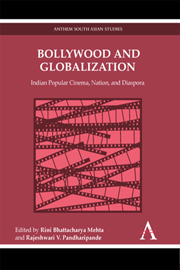Book contents
- Frontmatter
- Contents
- Acknowledgements
- Notes on Contributors
- Chapter One Bollywood, Nation, Globalization: An Incomplete Introduction
- Chapter Two Sentimental Symptoms: The Films of Karan Johar and Bombay Cinema
- Chapter Three Is Everybody Saying ‘Shava Shava’ to Bollywood Bhangra?
- Chapter Four Bollywood Babes: Body and Female Desire in the Bombay Films Since the Nineties and Darr, Mohra and Aitraaz: A Tropic Discourse
- Chapter Five Globalization and the Cultural Imaginary: Constructions of Subjectivity, Freedom & Enjoyment in Popular Indian Cinema
- Chapter Six Rang De Basanti: The Solvent Brown and Other Imperial Colors
- Chapter Seven Between Yaars: The Queering of Dosti in Contemporary Bollywood Films
- Chapter Eight Imagined Subjects: Law, Gender and Citizenship in Indian Cinema
- Chapter Nine ‘It's All About Loving Your Parents’: Liberalization, Hindutva and Bollywood's New Fathers
- Notes
- Select Bibliography
Chapter One - Bollywood, Nation, Globalization: An Incomplete Introduction
Published online by Cambridge University Press: 05 March 2012
- Frontmatter
- Contents
- Acknowledgements
- Notes on Contributors
- Chapter One Bollywood, Nation, Globalization: An Incomplete Introduction
- Chapter Two Sentimental Symptoms: The Films of Karan Johar and Bombay Cinema
- Chapter Three Is Everybody Saying ‘Shava Shava’ to Bollywood Bhangra?
- Chapter Four Bollywood Babes: Body and Female Desire in the Bombay Films Since the Nineties and Darr, Mohra and Aitraaz: A Tropic Discourse
- Chapter Five Globalization and the Cultural Imaginary: Constructions of Subjectivity, Freedom & Enjoyment in Popular Indian Cinema
- Chapter Six Rang De Basanti: The Solvent Brown and Other Imperial Colors
- Chapter Seven Between Yaars: The Queering of Dosti in Contemporary Bollywood Films
- Chapter Eight Imagined Subjects: Law, Gender and Citizenship in Indian Cinema
- Chapter Nine ‘It's All About Loving Your Parents’: Liberalization, Hindutva and Bollywood's New Fathers
- Notes
- Select Bibliography
Summary
Bollywood, or Bombay Cinema, or Indian Entertainment Cinema went global in 1995, with Aditya Chopra's Dilwale Dulhaniya Le Jayenge (The True of Heart Will Win the Bride). DDLJ, as the film came to be called (in the 1990s' style of abbreviating long Bollywood titles), outperformed Maine Pyaar Kiyaa (I Have Loved, 1989) in the box office which in its day had outperformed the long-time record-holder Sholay (Flames, 1975). In DDLJ, the Non Resident Indian (the NRI), hitherto portrayed in Hindi films as the marginal outsider with affected speech and behavior was redeemed and validated as not just a possible Indian national subject, but possibly one of the best. This film had a storyline highly unusual for its time. Baldev Singh, a Punjabi storeowner in England returned to India to marry off her daughter Simran to a native Indian Punjabi. The daughter had already had a brief romantic encounter with a Punjabi British man named Raj, and was determined to marry him. But Raj, who then followed Simran and her family to India, would marry Simran only if she was ‘given away’ in the ‘traditional Indian way,’ by her father Baldev Singh. Baldev's impression of Raj from a brief encounter was that of an irresponsible individual with no sense of ‘tradition,” someone who was just not ‘Indian enough’. But as the narrative unfolded, Raj proved his ‘worth’ and Indian-ness to Baldev, ‘won’ the bride, and the film ended with the newly-weds returning to England, as Indians as they ever were.
- Type
- Chapter
- Information
- Bollywood and GlobalizationIndian Popular Cinema, Nation, and Diaspora, pp. 1 - 14Publisher: Anthem PressPrint publication year: 2010
- 7
- Cited by



